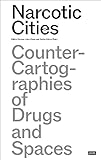Narcotic Cities : Counter-Cartographies of Drugs and Spaces / ed. by Mélina Germes, Stefan Höhne, Luise Klaus.
Material type: TextPublisher: Berlin : JOVIS, [2023]Copyright date: ©2023Description: 1 online resource (320 p.)Content type:
TextPublisher: Berlin : JOVIS, [2023]Copyright date: ©2023Description: 1 online resource (320 p.)Content type: - 9783986120009
- 9783986120184
- Anti-Drogen-Politik
- Counter-mapping
- Critical mapping
- Dekriminalisierung
- Drogen
- Drogenkartographien
- Konsumräume
- Kriminalisierung
- Marginalisierung
- Prohibition
- Verdrängung
- Verflechtungen
- digitale Räume
- kritische Kartographie
- öffentlicher Raum
- ARCHITECTURE / Individual Architects & Firms / General
- AlphaBay
- Amsterdam
- Berlin
- Bogotá
- Bordeaux
- Erowid
- Junkie Mokum
- Lisbon
- London
- Madrid
- Milan
- Paris
- Philippines
- Ukraine
- Vancouver
- addiction
- anti-drug policies
- apartment-based dealing
- body mapping
- coca farming
- counter-cartography
- counter-mapping
- criminalization
- critical cartography
- critical geography
- critical mapping
- digital drug markets
- displacement
- drug cartography
- drug policies
- drug users' spaces
- heroin
- kratom
- law enforcement
- lockdown
- marginalization
- needle map
- open drug scene
- open-air fumoirs
- paramap
- police drug map
- prohibition
- public space
- pyatak
- smoking ban
- spaces of consumption
- war on drugs
- 360
- online - DeGruyter
- Issued also in print.
| Item type | Current library | Call number | URL | Status | Notes | Barcode | |
|---|---|---|---|---|---|---|---|
 eBook
eBook
|
Biblioteca "Angelicum" Pont. Univ. S.Tommaso d'Aquino Nuvola online | online - DeGruyter (Browse shelf(Opens below)) | Online access | Not for loan (Accesso limitato) | Accesso per gli utenti autorizzati / Access for authorized users | (dgr)9783986120184 |
Frontmatter -- Table of Contents -- Acknowledgments -- Introduction -- Don’t Map Drugs! -- DE-/RECONSTRUCTING -- Numbering Babylon? -- What’s in a (Police) Drug Map? -- Behind a Berlin Needle Map -- The Hotspot -- Blanks in the Maps -- POLICIES AND SPACE -- Coca, Cattle, and the Forest -- Anti-Drug Vigilante Killings in the Philippines -- URBAN HISTORY -- The Stockholm Smoking Bans -- Taverns, Clubs, and Homes -- Media and the Dystopian City -- “Map of Junkie Mokum”. -- Small-Time Dealing -- ONLINE GEOGRAPHIES -- A Global Digital Market? -- Substantiated Spaces -- Using Kratom -- AMBIVALENT EMOTIONS -- Counter-Addiction Stories -- The Secret across the Street -- (Post-)Lockdown Mapping -- Party, Emotions, and Gender -- Traces. -- URBAN STRUGGLES -- Displaced. -- Open-Air Fumoirs -- Pyatak Drifters -- Weaving Drug Users’ Spaces of Care and Sociality in Vancouver and Paris -- An Ideal City for Marginalized Drug Users in Germany? -- Contributors -- Table of Figures -- Imprint
restricted access online access with authorization star
http://purl.org/coar/access_right/c_16ec
Angesichts der aktuellen Debatten zur Entkriminalisierung von Drogen ist eine Auseinandersetzung mit Drogenkarten längst überfällig. Narcotic Cities spürt den komplexen Verflechtungen von Drogen, Institutionen, Erfahrungen und ihren räumlichen Repräsentationen nach und wirft so ein neues Licht auf unsere Städte. Durch das Medium grafischer Essays untersucht dieses Buch urbane Erzählungen sowie historische und politische Zusammenhänge, Gemeinschaften, digitale Räume und das mit Drogen verbundene Vergnügen. Es versammelt Beiträge von mehr als 40 Autor*innen, die auf Geoinformationssystemen, Handzeichnungen, Satellitenbildern und Erinnerungen basieren. Dieser Einsatz diverser grafischer Sprachen ergibt ein reichhaltiges Mosaik urbaner, aber auch multiskalarer Perspektiven auf das Thema Drogen, das sowohl wenig bekanntes Wissen als auch Überlegungen zu den Fallstricken, Auslassungen und Misserfolgen von Drogenkartografien enthält.
With debates about the decriminalization of drugs on the rise, an exploration of drug maps is long overdue. Narcotic Cities traces the complex entanglements of drugs, institutions, activities, and the way they are represented with spaces and places, shedding new light on our cities. Through the medium of graphic essays, this book explores urban stories, as well as the histories, policies, communities, digital spaces, and pleasures associated with drugs, gathering together more than forty contributors working with Geographic Information Systems, hand drawings, satellite images, and memories. By experimenting with different graphic languages, this volume assembles a rich mosaic of multi-scalar urban perspectives on drugs, sharing little-known knowledge as well as reflections on the pitfalls, omissions, and failures of drug cartographies.
Issued also in print.
Mode of access: Internet via World Wide Web.
In English.
Description based on online resource; title from PDF title page (publisher's Web site, viewed 02. Jun 2024)


